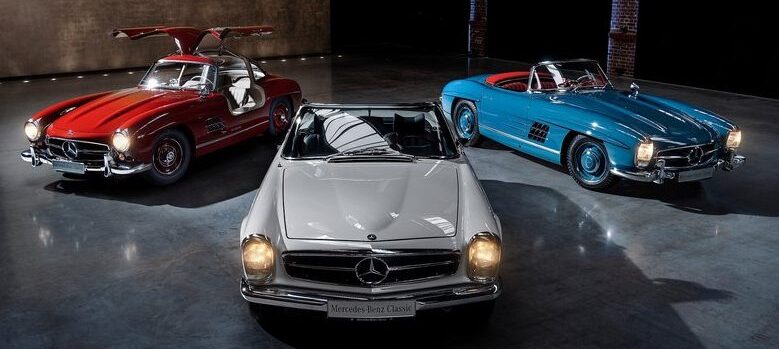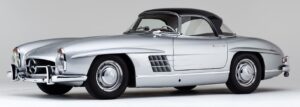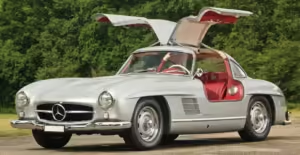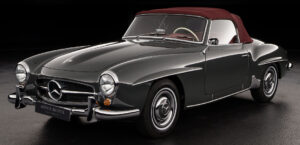Mercedes leading the way in the evolution of the SL
1. 1954-1963: Mercedes-Benz W198 SL
1954-1963: Mercedes-Benz W198 SL
In 1950, the world of motorsport was introduced to a revolutionary era characterized by advancements in aerodynamics and speed when three Jaguar XK120 cars made their appearance at the prestigious Le Mans 24 Hours race. Although these remarkable vehicles faced mechanical failures during the competition, their innovative design and engineering prowess captured the attention of many automotive enthusiasts and industry leaders alike. Among them was the management team at Mercedes-Benz, who recognized the urgent need to develop a lightweight, aerodynamic sports car capable of competing in this burgeoning segment of high-performance vehicles.
In response to this challenge, Mercedes-Benz set out to create a model that not only exemplified cutting-edge technology but also appealed to a growing market of performance-oriented drivers. By 1951, the groundwork for this ambitious project was laid with the development of a new model, which underwent rigorous initial testing at the Nurburgring, one of the most demanding racetracks in the world. This pivotal moment marked the official birth of the Mercedes-Benz SL series, a line of cars that would become synonymous with luxury, performance, and innovation.
The introduction of the SL series represented a significant milestone in automotive history, as it combined advanced engineering techniques with the timeless elegance that Mercedes-Benz is known for. As the 1950s progressed, the SL series evolved to meet the demands of both motorsport enthusiasts and luxury consumers, setting the stage for future innovations in the automotive industry. With a focus on weight reduction and aerodynamic efficiency, the Mercedes-Benz SL series would go on to define a new standard for sports cars, paving the way for subsequent generations of high-performance vehicles.
The Mercedes-Benz 300SL, known internally as the W198, was a groundbreaking model that utilized a true space frame chassis, focusing on weight reduction and aerodynamics. The initial design phase was so focused on these elements that the early prototype lacked bodywork and doors entirely. The innovative tubular space frame necessitated an unconventional door design, leading to the creation of the iconic gullwing doors. This unique solution was both a technical necessity and a design breakthrough.
The iconic 300SL gullwing
The road-going version of the 300SL was unveiled in January 1954 at the International Motor Sports Show in New York, causing a sensation. The car’s advanced engineering, combined with its unique aesthetics, made it an instant classic. Hand-built with meticulous attention to detail, the 300SL was expensive to produce and buy.
The 300SL was powered by a 3.0-liter inline-6 engine producing 211 hp in the coupe variant (1954–1957) and 221 hp in the roadster variant (1957–1963). This robust engine, combined with the lightweight chassis, delivered remarkable performance for the time.
1955-1963: The W121 190SL
To complement the high-end 300SL, Mercedes-Benz introduced a more accessible model, the 190SL, in 1955. Priced at $3,998, it was significantly cheaper than the 300SL but still more expensive than many European rivals. However, the 190SL offered higher levels of sophistication, reliability, and practicality. Available as a convertible or a coupe with a removable hardtop, the 190SL set a precedent for future SL models.
Powered by a 1.9-liter inline-4 engine producing 102 hp, the 190SL wasn’t as powerful as its bigger sibling but was appreciated for its elegance and usability. The success of both the 300SL and 190SL solidified Mercedes-Benz’s position in the luxury sports car market and set the stage for future developments.
Legacy of the W198
The W198 series, comprising the 300SL and 190SL, established a legacy of innovation, combining cutting-edge engineering with timeless design. The gullwing doors of the 300SL became an enduring symbol of Mercedes-Benz’s engineering prowess and creative thinking. Meanwhile, the 190SL demonstrated that luxury and performance could be made more accessible without compromising on style or quality.
The W198 models are celebrated today not only for their historical significance but also for their enduring appeal. Collectors and enthusiasts around the world regard these cars as some of the finest examples of automotive art and engineering. The legacy of the W198 series is a testament to Mercedes-Benz’s commitment to excellence and its ability to adapt and innovate in the competitive world of high-performance sports cars.
Are you already a proud owner of a Mercedes? If so, check out our selection of parts for this car at the following link:
https://octoclassic.com/product-category/mercedes-benz
Photos sources: Top Speed, pinterest.co.uk, derwac.com, nmaa.co.id











